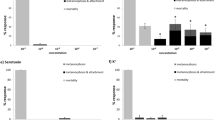Abstract.
Secondary metabolites synthesised by sessile invertebrates appear to play a role in creating and maintaining space on hard substrata by repelling competitors. In this study, we investigated the responses of the larvae of the ascidian Herdmania curvata to haliclonacyclamine A (HA), the major component of a suite of cytotoxic alkaloids extracted from the sponge Haliclona sp. 628. Both Haliclona sp. 628 and Herdmania curvata inhabit the crest and slope of Heron Island Reef. High rates of settlement were induced in competent H. curvata larvae by a range of concentrations of HA, all lower than that naturally occurring in the sponge. HA did not induce precompetent larvae to settle. Although early metamorphosis of HA-induced larvae was normal, larvae exposed to all but the lowest concentration of HA were developmentally arrested after completion of tail resorption, at about 4 h after the initiation of metamorphosis. These postlarvae underwent extensive cellular necrosis within 24 h. We also demonstrate that the addition of a transcriptional inhibitor, actinomycin D, to larvae also causes inhibition of metamorphosis after tail resorption is completed. Analyses of incorporation of radiolabelled nucleotides to measure levels of transcription during normal development and after the addition of the transcriptional inhibitor indicate that there is a significant burst of transcriptional activity just after tail resorption is completed. Despite inhibiting metamorphosis at the same stage as actinomycin D, HA increases initial rates of RNA synthesis after induction of metamorphosis in a manner similar to that observed in normal postlarvae until the onset of cellular necrosis. We conclude that HA initially induces H. curvata larvae to settle and progress through early metamorphosis possibly by engaging the same pathway as other artificial and environmental cues but subsequently inhibits completion of metamorphosis, resulting in death of the postlarvae. Since HA does not affect overall transcription rates, it appears to disrupt another important developmental process during early metamorphosis.
Similar content being viewed by others
Author information
Authors and Affiliations
Additional information
Electronic Publication
Rights and permissions
About this article
Cite this article
Green, .K., Russell, .B., Clark, .R. et al. A sponge allelochemical induces ascidian settlement but inhibits metamorphosis. Marine Biology 140, 355–363 (2002). https://doi.org/10.1007/s002270100698
Received:
Accepted:
Issue Date:
DOI: https://doi.org/10.1007/s002270100698




